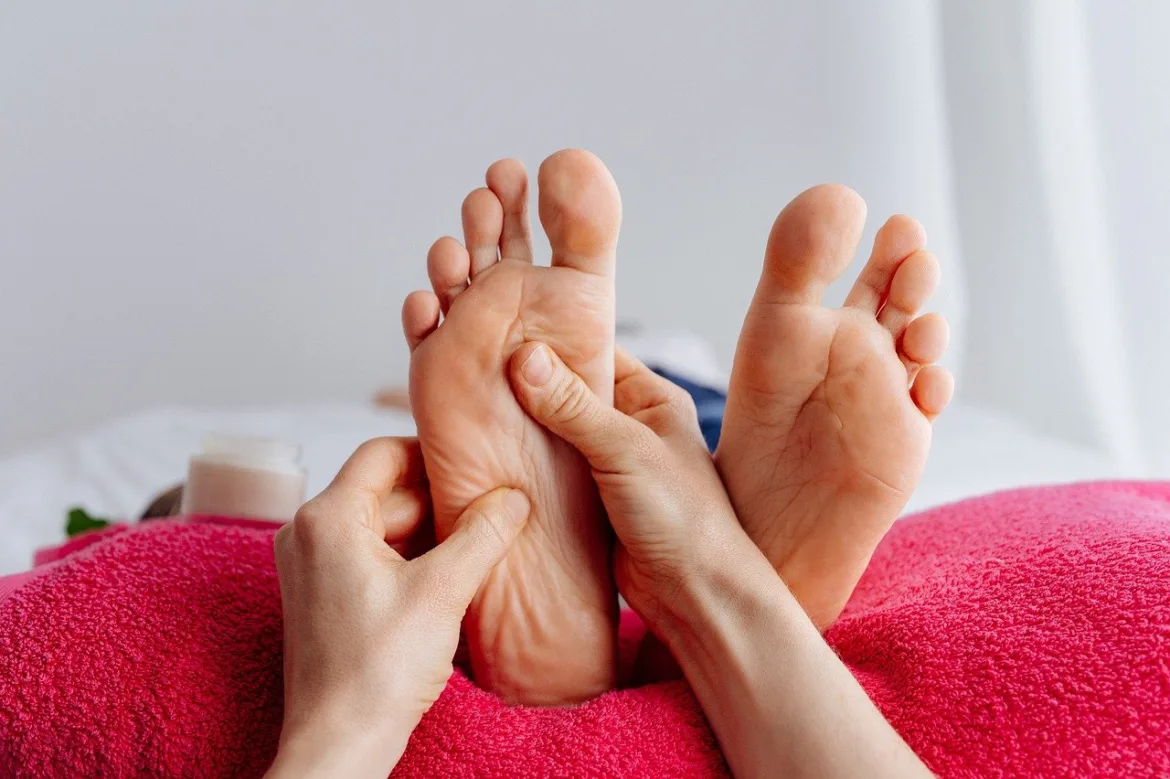Introduction
The power of Reiki Reflexology, where ancient healing techniques merge with modern wellness practices. In this comprehensive guide, we will explore the profound benefits and principles of Reiki Reflexology. Prepare to embark on a journey that combines the art of touch, the power of energy, and the innate healing abilities of the human body. Whether you’re new to alternative therapies or a seasoned practitioner, this article will provide you with valuable insights and information.

Table of Contents
What is Reiki Reflexology?
Reiki Reflexology is a holistic healing modality that combines the ancient practices of Reiki and reflexology. It involves the application of gentle pressure and massage techniques on specific reflex points in the hands, feet, and ears to stimulate the body’s natural healing response. Reiki, a Japanese word meaning “universal life energy,” refers to the channelling of energy through the practitioner’s hands to promote physical, emotional, and spiritual well-being. Reflexology, on the other hand, is based on the principle that there are reflex points in the body that correspond to different organs, glands, and systems.

Understanding the Reiki Reflexology Connection
Reiki and reflexology are interconnected through their shared belief in the body’s innate ability to heal itself. Both modalities recognize that imbalances in the body’s energy can lead to various health issues. By applying Reiki energy to specific reflex points, practitioners aim to restore harmony and balance within the body, allowing for natural healing to occur. The combination of Reiki and reflexology creates a powerful synergy that enhances the therapeutic effects of each practice.
The History and Origins of Reiki Reflexology
The origins of Reiki Reflexology can be traced back to ancient civilizations, where the healing power of touch and energy was widely recognized. However, the modern practice of Reiki Reflexology can be attributed to Dr Mikao Usui, a Japanese Buddhist monk who rediscovered the ancient healing technique of Reiki in the early 20th century. Dr Usui’s teachings and methods have since been passed down through generations, evolving into various branches and approaches, including the integration of reflexology.
The Science Behind Reiki Reflexology
While the concept of energy healing may seem abstract, scientific research has shed light on the mechanisms underlying Reiki Reflexology. Studies have shown that Reiki can induce a state of deep relaxation, activate the parasympathetic nervous system, and promote the release of endorphins, which are the body’s natural painkillers. Reflexology, on the other hand, has been found to stimulate nerve pathways, improve blood circulation, and enhance the body’s ability to self-regulate and heal.

The Benefits of Reiki Reflexology
Reiki Reflexology offers a wide range of benefits for individuals seeking to enhance their well-being. Some of the key benefits include:
- Stress Reduction: Reiki Reflexology promotes deep relaxation, alleviating stress and tension in the body and mind. It can help release blocked energy, allowing for a greater sense of calm and tranquillity.
- Pain Management: By stimulating reflex points and applying Reiki energy, Reiki Reflexology can help reduce pain and discomfort in various areas of the body. It is particularly effective for addressing issues such as headaches, back pain, and musculoskeletal conditions.
- Improved Circulation: The massage techniques used in Reiki Reflexology help enhance blood circulation, promoting the delivery of oxygen and nutrients to different parts of the body. This can support the body’s natural healing processes and contribute to overall well-being.
- Enhanced Energy and Vitality: Reiki Reflexology revitalizes the body’s energy flow, boosting vitality and enhancing overall energy levels. It can help combat fatigue, improve stamina, and restore a sense of vitality and zest for life.
- Emotional Balance: Reiki Reflexology not only addresses physical imbalances but also supports emotional well-being. The deep relaxation and energy balancing effects can help reduce anxiety, uplift mood, and promote emotional stability.
- Holistic Healing: Reiki Reflexology takes a holistic approach to healing, addressing the interconnectedness of the body, mind, and spirit. By promoting balance and harmony within the whole person, it supports comprehensive healing on multiple levels.

Exploring Reiki Reflexology Techniques
Reiki Reflexology encompasses a variety of techniques and approaches that can be tailored to individual needs. Here are some commonly used techniques:
- Thumb Walking: This technique involves using the thumb to apply gentle pressure and circular movements on specific reflex points. It stimulates the corresponding organs or systems, promoting healing and relaxation.
- Finger Rolling: Finger rolling is a technique where the fingers are used to apply rolling and stretching motions on reflex points. It helps release tension, improve flexibility, and enhance energy flow.
- Hand Reflexology: Hand reflexology focuses on the reflex points in the hands. It is a convenient alternative for those who may have sensitive feet or prefer a portable self-care option.
- Ear Reflexology: Ear reflexology involves stimulating reflex points on the ears, which correspond to different parts of the body. It can be done through gentle massage or the use of specialized reflexology tools.
- Combining Reiki and Reflexology: Integrating Reiki energy with reflexology techniques amplifies the healing effects. Practitioners channel Reiki energy through their hands while applying reflexology techniques, creating a potent combination.

Integrating Reiki Reflexology into Your Wellness Routine
If you’re interested in incorporating Reiki Reflexology into your wellness routine, here are some tips to get started:
- Find a Qualified Practitioner: Look for a certified Reiki Reflexology practitioner who has undergone proper training and has a good reputation. They can provide personalized sessions tailored to your needs.
- Self-Care Practices: Learn simple reflexology techniques that you can use for self-care at home. This allows you to reap the benefits of Reiki Reflexology anytime, anywhere.
- Combining with Other Modalities: Reiki Reflexology can complement other wellness practices such as meditation, yoga, aromatherapy, and acupuncture. Integrating these modalities can enhance overall well-being.
- Consistency is Key: To experience the full benefits of Reiki Reflexology, regular sessions are recommended. Consistency allows for deeper relaxation, energy balance, and lasting effects.
Common Misconceptions about Reiki Reflexology

Despite its growing popularity, there are some misconceptions surrounding Reiki Reflexology. Let’s address a few of them:
- It’s Just a Placebo Effect: While the power of the mind cannot be underestimated, scientific research supports the effectiveness of Reiki Reflexology beyond the placebo effect. Numerous studies have shown positive outcomes and physiological changes associated with these practices.
- It Conflicts with Medical Treatments: Reiki Reflexology is a complementary therapy that can be used alongside conventional medical treatments. It is not intended to replace medical care but rather to support the body’s natural healing processes.
- It’s Only for the Spiritually Inclined: Reiki Reflexology is for everyone, regardless of their spiritual beliefs or background. Its benefits extend to physical, mental, and emotional well-being, making it accessible to individuals from all walks of life.

Conclusion
Reiki Reflexology offers a unique and powerful approach to holistic healing. By combining the principles of Reiki and reflexology, it taps into the body’s natural healing abilities, promoting balance, relaxation, and overall well-being. Whether you seek stress relief, pain management, or emotional balance, Reiki Reflexology can be a valuable addition to your wellness journey. Embrace the transformative power of touch, energy, and intention as you explore the boundless possibilities of Reiki Reflexology.

FAQs
Can Reiki Reflexology cure specific diseases?
Reiki Reflexology does not claim to cure specific diseases. However, it can support the body’s natural healing processes and contribute to overall well-being. It is best used as a complementary therapy in conjunction with medical treatments.
How long does a Reiki Reflexology session last?
The duration of a session can vary depending on individual preferences and needs. Typically, a session lasts between 60 to 90 minutes. However, shorter sessions can still provide beneficial results.
Is Reiki Reflexology safe during pregnancy?
Reiki Reflexology can be safe and beneficial during pregnancy. However, it is essential to consult with a qualified practitioner who has experience working with pregnant individuals.
Can I learn Reiki Reflexology to practice on myself?
Absolutely! There are various training programs available that teach Reiki Reflexology techniques for self-care. Learning these techniques can empower you to support your own well-being.
Are there any contraindications for Reiki Reflexology
While Reiki Reflexology is generally safe, there may be contraindications for certain conditions or circumstances. It is important to discuss any pre-existing health conditions with a qualified practitioner before receiving a session.
How can I find a reputable Reiki Reflexology practitioner?
You can start by asking for recommendations from trusted sources such as friends, family, or healthcare providers. Additionally, professional associations and directories can help you find certified practitioners in your area.



